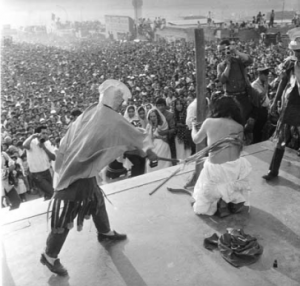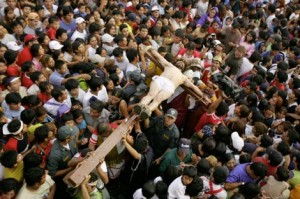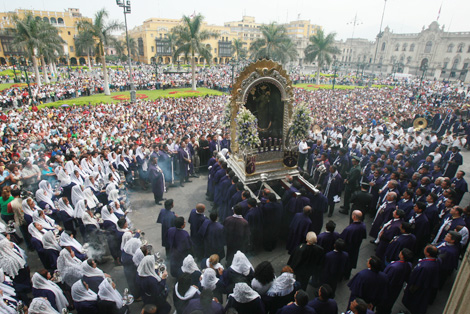SEMANA SANTA A LA LIMEÑA
De las diversas tradiciones de nuestra ciudad, la Semana Santa es una de las más reconocidas y seguidas. El pueblo peruano y, especialmente, el limeño han experimentado la Vida y Pasión de Cristo con admirable fervor religioso, herencia española con la que nos insertamos en el mundo católico.
Of the diverse traditions of our city Lima, the Holy Week is one of the most widely known and followed. A Peruvian city and, especially, the city of Lima have experienced the life and passion of Christ with admirable religious fervor and Spanish heritage with which we entered the Catholic world.
Estos días recogen el tiempo que conmemora la pasión de Cristo. En Lima se celebra con especial particularidad. Es muy antigua la costumbre en que caravanas religiosas se dirigían hacia la Plaza de Armas, comenzando todo desde el “Miércoles de Ceniza”, tiempo en que finalizan los carnavales, para dar paso a la Cuaresma, período de conversión espiritual que nos prepara para recibir estos días santos.
These days of the Holy Week commemorate the passion of the Christ. In Lima, it is celebrated in an especially peculiar way. It is a very old custom in which the religious convoys are directed to the Plaza de Armas, where they begin with Ash Wednesday, which marks the end of the carnivals and the beginning of Lent, a time of Spiritual reflection to prepare oneself to receive these sacred days.
Desde el Domingo de Ramos hasta el Domingo de Resurrección, procesiones que muestran los pasos de la Pasión de Cristo y los Dolores de la Virgen María recorren las calles más importantes de la Lima colonial. Hasta entonces, algo típico de estas fechas era visitar las siete iglesias en jueves Santo.
From Palm Sunday until Resurrection Sunday, processions that show the Passion of Christ and the Pain of the Virgin Mary flood the most important streets in Lima. Until that day, it is common to visit seven churches on Holy Thursday.
Comer carne de pescado y escuchar el Sermón de las Siete Palabras son las tradiciones para el jueves y Viernes Santo, mientras que el sábado y domingo debíamos guardar luto y asistir a las misas o procesiones con velos y ropa de duelo.
Eating fish and listening to the sermon about the Seven Words are traditions for Holy Thursday and Friday, while Saturday and Sunday are reserved for mourning and attending masses and processions wearing veils and somber clothing.
Con el pasar de los años, y la llegada de las nuevas generaciones, estas costumbres se fueron diversificando; y, además de las celebraciones religiosas, surgieron improvisados grupos teatrales de barrio, que realizaban realistas y sentidas representaciones de la Pasión de Cristo. Años después, otros barrios hicieron sus propias adaptaciones. Hoy una de las más concurridas es la que se desarrolla en el Cerro San Cristóbal.
With the passing of years and the arrival of new generations, these customs were diversified, and, along with the religious celebrations, improvisational theater groups began to perform representations of the Passion of Christ. Years after that, other parts of Lima made their own adaptations. Today one of the busiest is the performance carried out on the Cerro San Cristóbal.
Esta escenificación, atrae a muchos seguidores, entre residentes y visitantes, quienes con mucha fe y devoción acompañan a pie al denominado “Cristo cholo” hasta la cumbre del cerro tutelar de Lima. Desde el año 2000, el Señor de los Milagros acompaña a sus fieles en una corta procesión en viernes Santo.
This performance attracts many followers from residents to visitors, especially those with a strong faith and devotion who travel on food to follow the named “Cristo cholo (dear Christ)” to the top of this guardian hill of Lima. Since 2000, el Señor de los Milagros accompanies his faithful believers in a short procession on Holy Friday.
Además de esto hay algunas costumbres diferentes, algunas personas aprovechan estos días para realizar turismo interno, ya sea realizando paseos familiares, visitando centros comerciales o acampando en playas y bosques en las afueras de Lima.
Along with this there are many different customs, even for those who take advantage of these days to make the best of the tourism. Some come to take this familiar Holy Week trek, visiting commercial centers or camping on the beaches and in the forests outside of Lima.
Encuestas recientes dicen que cada vez hay menos católicos en el Perú. Sin embargo, este hecho se contradice al ver como celebramos nuestras principales fechas religiosas (Semana Santa y Navidad), no solo en Lima, sino también en provincias, donde la fe se muestra más colorida y no menos fuerte. Y entonces, ¿cómo dudar que los limeños, aún creen en Dios, si el Perú es un país que manifiesta su fe con verdadera devoción?
Recent surveys have shown that every year there are fewer Catholics in Perú. However, this fact is contradicted when it is seen how many come to partake in these principle religious celebrations (Holy Week and Christmas), not only in Lima, but in other provinces, where faith is colorfully shown in obvious ways. Furthermore, how can we doubt that those who live in Lima believe in God if Perú is a country that shows its faith with true devotion?
Extraído de Huellas Digitales/ Autor: Archivo Histórico El Comercio
Taken from Huellas Online/ Author: Archivo Histórico El Comercio


